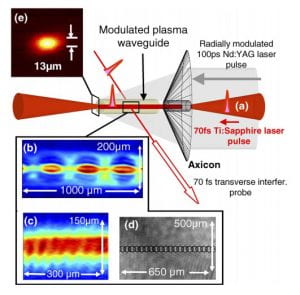Corrugated plasma channels enable electron acceleration that scales directly with laser field strength, making relativistic electron bunch generation possible with smaller, high repetition rate laser systems.
Applications of the interaction of intense laser pulses with matter, which include laser-driven particle acceleration and light sources such as x-ray lasers, coherent EUV/x-ray generation and terahertz generation, rely on achieving high intensities over a long interaction length. However, diffraction imposes a trade-off between peak intensity and focal volume, since focusing a laser pulse more tightly in space causes more rapid divergence to a larger spot with lower intensities.
Waveguides, such as optical fibers, are the solution to this problem, extending the range over which the laser has a high intensity. However, conventional glass fiber optics have a damage threshold set by the critical power for self-focusing, ~ 3 MW, rendering such optics useless for pulses that can reach 30 TW in our lab. The only option for guiding extremely intense pulses is to make a waveguide composed of plasma—which requires a channel with a low plasma density on axis and higher density on the sides. Our lab first demonstrated the plasma waveguiding of ultraintense laser pulses, and is now investigating modifications that will increase the versatility of these plasma micro-optics.
Scaling down plasma accelerators with direct acceleration by a laser field
In conventional laser wakefield acceleration (LWFA), electrons are not directly accelerated by the laser field, but are instead pushed along by the electrostatic fields in the nonlinear plasma wake of an intense pulse. For a given plasma density, this demands a threshold ultrashort pulse laser energy—which can be rather high—to generate a plasma wake of sufficient amplitude. Alternative schemes that try to accelerate electrons directly with the laser field are limited to very short interaction regions near a material boundary or at a tight focus, strongly limiting the acceleration. Our lab has developed a variation on the plasma waveguide that enables direct acceleration of electrons by the laser field. By adding periodic modulations in the channel density or diameter, components of a guided, radially polarized laser pulse can propagate at less than the speed of light. This allows acceleration of electrons directly by the laser field, even with very low laser powers.
Direct acceleration is possible because a component of the radially polarized electric field points along the pulse propagation direction (along the waveguide). In a vacuum or a straight waveguide, such a field would provide no net acceleration, since any forward push in the propagation direction would immediately be canceled by a backward push when the electric field points in the opposite direction on the other half of the optical cycle. The role of the modulated plasma waveguide is to emphasize the forward pushes and suppress the backward pushes. This “quasi phase matching” results in net acceleration which is directly proportional to the laser field and has no threshold—unlike LWFA—needed to achieve acceleration. A paper describing our acceleration mechanism is found here, while additional papers simulating improvements to the scheme are found here and here.
Image from [1]
Experimental realization of corrugated channels
This goal has driven several advances in our lab towards a variety of modulated plasma waveguides. Initially, we explored imaging a ring grating onto the channel forming pulse to form these density perturbations, as pictured below. We then demonstrated direct modulation in density from wires placed over an elongated gas jet and explored the effect of shocks in this setup as the gas is cooled. Recently, we published results on using a programmable spatial light modulator in an interferometric setup to introduce arbitrary periodic modulations in the gas jet, as shown below and described here.
Left/center, radial modulations are focused by an axion to create axial modulations [1]. More flexibility can be obtained with wires obstructing the jet (not pictured), and even more so by a programmable interferometric setup, as shown on right. Image from [2].
References:





